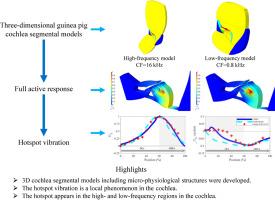The mechanism of the active cochlea relies on a complex interaction between microstructures in the organ of Corti. A significant longitudinal vibration “hotspot” was recently observed in the high-frequency region of the living gerbil cochlea between the Deiters cells and the outer hair cells. A similar phenomenon was also found in guinea pigs with a relatively smaller magnitude. The cause is unknown, but one hypothesis is that this phenomenon is due to the structural constraints between different microstructures. It is not easy to explain the mechanism of hotspots directly from experimental observations. It may also be difficult to image or test if the hotspot will occur in the low-frequency region in the cochlea. We built two three-dimensional finite element models corresponding to the high- and low-frequency regions in the guinea pig cochlea. Responses of the organ of Corti to passive acoustic and outer hair cell electrical excitation were calculated. The two excitations were then superimposed to predict the active response of the organ of Corti. The hotspot phenomenon in the experiment was reproduced and analyzed in-depth about influencing factors. Our results indicate that hotspots appear in the low-frequency region of the cochlea as well. We hypothesize that the hotspot is a locally originated phenomenon in the cochlea, and the traveling wave further enhances the response to low-frequency excitation. The movement of outer hair cells inclined in the longitudinal direction is the leading cause of the hotspot.


